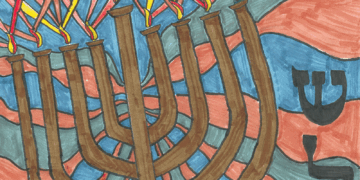When I was a child, as my mother was preparing for Pesach — putting all of the crackers, cereal boxes, bread crumbs, etc. into a large cardboard box and stowing it in the basement — I declared that Passover was a sham: Moses was a fictional character and the Exodus story was made up.
As I recall, the source for my newfound skepticism was H.G. Wells’ Outline of History, a two-volume set that came with a book club membership. My mom responded that Wells was an anti-Semite. There seems to be evidence of this claim, including Wells’ anti-Semitic characterizations in his science fiction novel War of the Worlds. Wells was opposed to the Zionist movement, which was known as “Territorialism” in Great Britain; however, he had a change of heart after the horrific extent of the Holocaust was revealed. Generally, Wells was not a friend of Jews, and expected that they eventually would assimilate into the general population.
(Since this is the Passover special edition, I’ll mention that Jews in Minnesota encountered some shortages as they prepared for their seder meals after World War II. Al Weisman, of the Weisman Company, which supplied “this territory with many nationally advertised products that adorn the Passover table,” told the Jewish World that “shortages, transportation difficulties and strikes hampered us in getting many items we all have been accustomed to eating during the holidays. Yet, we do not believe anyone will go hungry because of this situation” [4-5-46 AJW]. Weisman noted that products “containing sugars, such as jellos, chocolates and preserves are completely off the market, but we were able to substitute these delicacies with fruit cuts, honey, sponge cakes, and confectionary.”)
But back to the historicity of Moses. Did he really lead the Children of Israel out of Egypt?
“In modern times the historicity of Moses — and the Exodus tradition as a whole — has been challenged; but many scholars agree that some of the tribes were in fact enslaved in Egypt and freed, that the Israelite religion was founded in law by a solemn covenant, and that a heroic figure like Moses played a central role in these events,” Shalom Paul wrote in “Moses,” in The Oxford Dictionary of the Jewish Religion.
The quotation from Paul appears in a blog titled Ancient Hebrew Poetry, which is the work of biblical scholar John F. Hobbins. In a post titled “The Historicity of Moses,” Hobbins, who apparently is not Jewish, writes about the giving of the Torah on Mount Sinai, Aaron’s golden calf, etc., and declares: “It’s all self-evidently true, though it is not a photograph of reality. It is more like a Klee, a Picasso, or a Chagall, whose abstract colors and forms, abstract and specific at the same time, speak a precise language.”
Hobbins considers Moses from various angles, including the view that “once upon a time there was someone named Moses. Historically speaking, we don’t know much for certain about him. We don’t even know where he was buried. But if the God of Moses exists, then so does Moses, and he’s probably speaking with Elijah this very moment. But of that reality we can say very little.”
So, the historical context of the upcoming holiday is a bit elusive (as I suggested to Mom, aleha ha’shalom). But there are some great stories; and we love sitting around the seder table recounting the redemption of our people, as if it happened to us. The story of the Israelites’ perilous flight out of Egypt has captured the imagination of peoples throughout the ages, in far-flung lands. Some families incorporate the African-American spiritual “Go Down, Moses,” into their seders: “When Israel was in Egypt’s land: Let my people go, / Oppress’d so hard they could not stand, Let my People go. / Go down, Moses, / Way down in Egypt’s land, / Tell old Pharaoh, / Let my people go.”
In the song, “Israel” represents the oppressed slaves in the American South, and “Pharaoh” represents the slavemaster. The Exodus story, which is the story of the birth of the Jewish people, represented hope for those enduring chattel slavery in this country. And Passover also celebrates the “rebirth” of the natural world after the dormancy of winter; another name for Pesach is Chag Ha’Aviv, the Spring Holiday.
While most American Jews have drifted away from strict observance of halacha, rabbinic law, especially in respect to the dietary laws, it is a curious thing that many Jews who do not otherwise keep kosher refrain from eating leavened foods during Passover. And another oddity, which took place recently, was the swarm of locusts that invaded Israel from Egypt. I’m not attaching any ominous meaning to this infestation that occurred in the run-up to Passover; but, as many commentators noted, it recalled the eighth plague on Egypt, in reverse.
As it happens, locusts are kosher, and blogs in Israel featured recipes for dishes such as honey-spiced locusts. Allison Kaplan Sommer, writing in Haaretz, suggested: “As the only kosher insect, they are perfect for the hostess who hasn’t yet decided on an interesting appetizer for the Passover seder meal.”
And Rabbi Natan Slifkin wrote about the insects for the The Times of Israel news blog recently: “The rationale for certain locusts being kosher may be a practical matter — when your crops are wiped out by locusts, at least you’re not left with nothing to eat! But in modern Western society, eating bugs simply grosses out most people.”
And Slifkin’s final point should be expanded upon in our upcoming “Living Green” special section, which will appear in the March 29 AJW: “Can you imagine what an impact it would make if Jews were known not for exploiting animals in factory-farming and indulging in massive gastronomic excesses, but instead for adopting a more environmentally and animal-friendly approach? In fact, eating locusts doesn’t even make you fleishig, so you could have a locust cheeseburger. I say, let’s get back to our biblical roots and tuck in. Bon appétit!”
And Happy Passover to all of our readers, from the editors and staff of the American Jewish World.
— Mordecai Specktor / editor@ajwnews.com
(American Jewish World, 3.15.13)



















